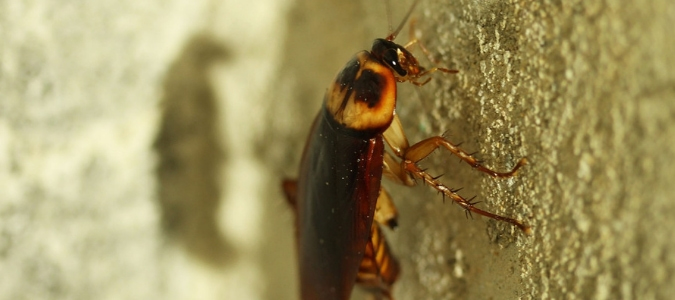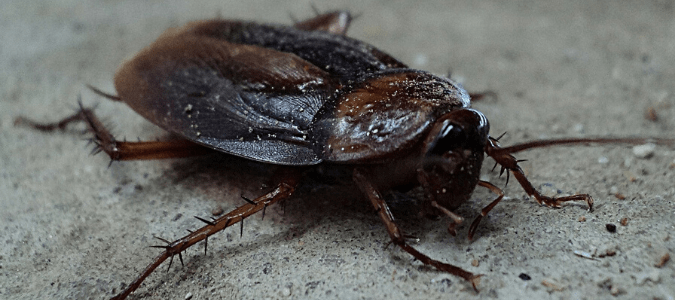They are huge, they can spread disease, they run fast and they can even fly—what are we talking about? If you answered “palmetto bugs,” you’re not wrong. That’s the far nicer-sounding name for the crawling insects also known as American cockroaches or smokybrown cockroaches. Whatever you choose to call these common bugs, you know after some time in this state that it’s not uncommon to see a flying cockroach in Florida. If you’re like most people, the sight of one hurtling through the air or zooming across your floor will make you shriek or at least raise your heart rate a notch or two.
There are plenty of flying bugs that are common in Florida, including mosquitoes and wasps. But somehow, flying cockroaches are extra horrifying, even if they don’t bite or sting. They’re just so big and they run so fast when they’re on the ground. Cockroaches of many varieties love Florida, since they thrive in warm, humid places. Florida is home to two varieties that are quite common: American cockroaches and smokybrown cockroaches.
American Cockroaches
American cockroaches are oval-shaped and flat. They have six jagged legs, two antennae and a pair of long wings that lie close to their backs when they aren’t flying. This type of cockroach is the largest of the most common types of roaches and can grow to two inches long with a medium-brown body as well as a yellowish band right behind the head.
After heavy rains, American cockroaches can make their way into homes through plumbing systems and from shrubs and trees that are closeby or from branches that are close to rooflines. These roaches respond negatively to light, hiding close to sinks, water pipes, toilets and baths during the day, where conditions are suitable for their survival. American cockroaches can eat almost anything, including paper, hair, fruit, book bindings, cloth and other dead insects. One female can produce, on average, 150 young during the course of her life.
Smokybrown Cockroaches
Smokybrown cockroaches look similar to American cockroaches, which is why so many people confuse them with each other. In fact, many call both types of cockroaches “palmetto bugs”. There are certain differences, though. Adult smokybrown cockroaches are just a bit smaller than American cockroaches. These roaches typically grow to one and a quarter inches or one and a half inches in length, and are a darker brown color. Also, smokybrown cockroaches usually run slightly slower than American cockroaches, but they are often better at flying.
As with American roaches, smokybrown cockroaches typically live outdoors, but they do come inside people’s homes looking for food and water. These types of roaches can be found in crawl spaces, fireplaces and attics, as well as in roofs and rain gutters. Light can attach these flying roaches at night, and a leaky roof can also make your home vulnerable to an infestation.
Finding roaches in your home isn’t just shocking; it’s also cause for concern. Roaches can spread disease and create unsanitary conditions inside a home. Anything they touch can be contaminated, and they have been known to be a vector for salmonella and staphylococcus. Cockroach infestations are even linked to allergies and asthma.
If you find one cockroach in your home, it’s possible that it’s simply one that wandered in from outdoors. But if you see them regularly, you may have an infestation on your hands. If this is the case, it’s a good idea to try to figure out what attracted these pests indoors. Do you keep your kitchen clean, always wiping up crumbs and spills? Do you keep food, including pet food, stored in containers with tightly fitting lids? Are there sources of water inside your home, like pet bowls, leaky pipes or faucets, or standing water in houseplants, that may be attracting these pests?
Of course, cockroaches can live and thrive even in clean homes. As we already mentioned, these creatures can eat almost anything, including cardboard boxes, paper and even glue. They can also enter homes through very small gaps in window screens or underneath doors, so it’s important to make sure that screen doors and the screens on your windows are in good shape. If your home has weep holes, you can keep pests out by plugging them with steel wool.
Once cockroaches take up residence inside your home and start breeding, the problem can grow out of control fast. Cockroaches lay eggs in small, oval or rectangular egg cases, and, as we mentioned, a single female can produce hundreds of babies in her lifetime. If you’re experiencing a roach problem in your home, enlisting the help of a pest control specialist can save you time and trouble. These professionals know the quickest and most effective ways to control pests at all stages of their life cycle. A pro can quickly implement an effective solution, so your life can return to normal.
What to Do if You Find Cockroaches in Garage
Cockroaches don’t just infest homes. It’s also very common to find cockroaches in the garage. Here, they can often find the shelter, food and water they need—with less risk of crossing paths with a well-aimed shoe. This is because many people use garages not just for cars and lawn care tools, but also for storage space. If you keep garbage bins or cardboard boxes in your garage, they may be attracting cockroaches.
Even plastic storage bins can draw roaches if their lids don’t fit well. Cockroaches can eat almost anything you might have in these storage areas, including paper, cardboard and fabric. Keeping old books, clothes or linens in boxes or bins in the garage can turn your garage into a cockroach buffet. And keeping your garbage, compost or recycling bins in the garage is one of the biggest ways that people unknowingly attract cockroaches. These pests love devouring the many treats they can find inside these bins. If there is water inside the bins, or puddled in some part of your garage, even better for these opportunistic scavengers. That’s all cockroaches need not just to survive, but to thrive.
Just as with houses, however, cockroaches can infest even clean garages that are used only for parking cars and storing a few tools. This is partly because garages are so easy to enter. And, when the weather gets extra cold or rainy, cockroaches that normally live outside will seek shelter wherever they can, including inside these protected spaces.
Here are several steps you can take to make your garage less appealing to these pests:
- Don’t store garbage, recycling or compost bins in the garage. If you must store these items in your garage, make sure their lids fit very tightly, and wheel them out of the garage before opening them to be extra cautious.
- If you use your garage to store household items, opt for plastic or metal bins with tightly fitting lids rather than cardboard boxes. These will be better at keeping out all kinds of pests, including cockroaches.
- Close any holes along your home’s exterior. Garages often have more gaps that lead out to open air than houses do. If you go into your garage on a sunny day and close the door and turn off all the lights, you’ll probably be able to see light coming through cracks along the walls, at the floor level or around the garage door itself. To keep cockroaches out, these cracks and gaps will need to be sealed off, either with wire mesh or caulk, or with weatherstripping along the garage door.
A pest control specialist can help you tackle the big job of getting rid of cockroaches in your garage. They have access to the most effective products and techniques for addressing a pest problem. They will take your particular home and needs into account when determining the best, quickest and most comprehensive way to get rid of pests so they don’t overrun your property.
What to Do if You Detect a Cockroach Smell
Wait—there’s a cockroach smell? Yes, there definitely is, and it is both distinctive and unpleasant. Since cockroaches are nocturnal, many people may not even realize they have a cockroach problem, except for the smell from these pests. Cockroach pheromones are present in their droppings, and these pheromones are the source of their distinctive, musty odor.
Unfortunately, the more cockroaches there are, the stronger the scent they leave behind. This means that if you’re detecting a cockroach smell in your home, you may already have an extensive cockroach problem. In this case, it’s a wise idea to contact a pest control specialist who can identify whether the smell is actually a cockroach smell. If a professional can confirm that this odor is from cockroaches, your technician can also determine where the roaches are living and breeding, what elements in the home might be attracting them and what the best approach is to getting rid of them.
If your home has a cockroach smell, it’s wise to deal with the actual cockroaches before dealing with the smell. Once the pests have been treated and eliminated, you can get rid of much of their smell by deep-cleaning the areas with lots of roach activity. Look for cockroach droppings—little brown pellets, or what look like dried, brown droplets or streaks—on walls or baseboards, inside cupboards, in bookcases or on shelves. But even if you don’t find roach droppings, it’s a good idea to clean any area where roaches have been spotted.
It’s best to clean these surfaces with a cleaner containing bleach, if possible. If bleach might damage the surface, then you can use some other strong, effective cleaner. Be sure to wear protective gear such as rubber gloves and a face mask, since cockroach droppings and dead roaches can aggravate asthma and allergies.
If you have an extensive cockroach problem that is responsible for a foul odor, as we’ve already mentioned, it’s a good idea to enlist the help of a pest control professional instead of trying to tackle the issue on your own. Often, cockroach remedies that you can buy at the grocery store just aren’t strong or comprehensive enough to eliminate roaches, especially if they have infested the home. A professional can recommend the best products and techniques to get rid of them as well as steps you can take to keep them away once the infestation is brought under control. Your licensed technician can also set up a regular schedule to inspect your property and treat for pests, so you can keep your pest control population under control, year round.
ABC Can Eliminate Roaches and Prevent Their Return
Dealing with cockroaches can feel like a neverending battle which can turn terrifying if your roaches have wings. Instead of experimenting with DIY techniques that often only serve to prolong the problem, contact ABC Home & Commercial Services. We create customized pest control plans, so that you don’t have to worry about a close encounter with a flying roach, or any other unwelcome bugs or critters, anytime soon.


